Io
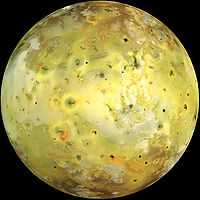
Io is a rocky-object that is irradiated by the Sun.
Io is also in a planetary-type orbit around Jupiter.
In the image at right, "[t]he smallest features that can be discerned are 2.5 kilometers in size. There are rugged mountains several kilometers high, layered materials forming plateaus, and many irregular depressions called volcanic calderas. Several of the dark, flow-like features correspond to hot spots, and may be active lava flows. There are no landforms resembling impact craters, as the volcanism covers the surface with new deposits much more rapidly than the flux of comets and asteroids can create large impact craters. The picture is centered on the side of Io that always faces away from Jupiter; north is to the top."[1]
Electromagnetics
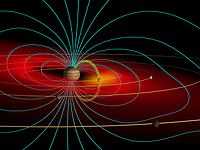
The image at right represents "[t]he Jovian magnetosphere [magnetic field lines in blue], including the Io flux tube [in green], Jovian aurorae, the sodium cloud [in yellow], and sulfur torus [in red]."[2]
"Io may be considered to be a unipolar generator which develops an emf [electromotive force] of 7 x 105 volts across its radial diameter (as seen from a coordinate frame fixed to Jupiter)."[3]
"This voltage difference is transmitted along the magnetic flux tube which passes through Io. ... The current [in the flux tube] must be carried by keV electrons which are electrostatically accelerated at Io and at the top of Jupiter's ionosphere."[3]
"Io's high density (4.1 g cm-3) suggests a silicate composition. A reasonable guess for its electrical conductivity might be the conductivity of the Earth's upper mantle, 5 x 10-5 ohm-1 cm-1 (Bullard 1967)."[3]
As "a conducting body [transverses] a magnetic field [it] produces an induced electric field. ... The Jupiter-Io system ... operates as a unipolar inductor" ... Such unipolar inductors may be driven by electrical power, develop hotspots, and the "source of heating [may be] sufficient to account for the observed X-ray luminosity".[4]
"The electrical surroundings of Io provide another energy source which has been estimated to be comparable with that of the [gravitational] tides (7). A current of 5 x 106 A is ... shunted across flux tubes of the Jovian field by the presence of Io (7-9)."[5]
"[W]hen the currents [through Io] are large enough to cause ohmic heating ... currents ... contract down to narrow paths which can be kept hot, and along which the conductivity is high. Tidal heating [ensures] that the interior of Io has a very low eletrical resistance, causing a negligible extra amount of heat to be deposited by this current. ... [T]he outermost layers, kept cool by radiation into space [present] a large resistance and [result in] a concentration of the current into hotspots ... rock resistivity [and] contact resistance ... contribute to generate high temperatures on the surface. [These are the] conditions of electric arcs [that can produce] temperatures up to ionization levels ... several thousand kelvins".[5]
"[T]he outbursts ... seen [on the surface may also be] the result of the large current ... flowing in and out of the domain of Io ... Most current spots are likely to be volcanic calderas, either provided by tectonic events within Io or generated by the current heating itself. ... [A]s in any electric arc, very high temperatures are generated, and the locally evaporated materials ... are ... turned into gas hot enough to expand at a speed of 1 km/s."[5]
X-rays
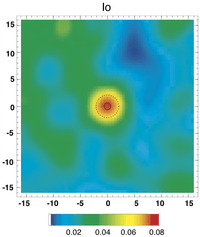
Weak X-ray signals have been detected from Jupiter's moon Io and from the Io Plasma Torus (IPT), a doughnut-shaped ring of energetic particles that circles Jupiter,[6] shown in the image on the right.
"Io’s atmosphere arises from sublimation of surface SO2 frost, sputtering of the surface by Jovian magnetospheric particles, and volcanic activity, with the latter perhaps be- ing the dominant contributor."[6]
Gases escape from Io and are trapped in an orbit around Jupiter, where they are accelerated to high energies.
Collisions between the particles within the Io Plasma Torus and the surface of Io can account for the observed X-rays to within a factor of approximately three; i.e., are too low by a factor of three.[6]
"The integrated ion energy flux at Europa for H, O, and S above 10 keV (Paranicas et al. 2001, Cooper et al. 2001) is ~ 1010 keV/s-cm2. The energetic ion flux at Io is ~5 times smaller, but is less well known than for Europa."[6]
"Chandra X-ray Observatory observations have shown that Io and Europa, and probably Ganymede, emit soft x-rays with 0.25-2.0 keV luminosities ~1-2 MW. This emission is likely to result from bombardment of their surfaces by energetic (> 10 keV) H, O, and S ions from the region of the IPT. The IPT itself emits soft x-rays with a 0.25-1.0 keV luminosity ~0.1 GW. Most of this emission appears at the low end of the energy band, but an unresolved line or line complex is apparent in the spectrum at an energy consistent with oxygen. The origin of the IPT x-ray emission is uncertain, but bremsstrahlung from non-thermal electrons may account for a significant fraction of the continuum x-rays."[6]
"The current-carrying electrons which strike [Io] will produce a flux of keV X-rays. At Earth this flux amounts to roughly 10-7 photons cm-2 s-1, which is about 6 orders of magnitude below the sensitivity of current X-ray surveys [as of 1969]."[3]
"Assuming the volume of a torus with semi-major axis equal to that of Io’s orbit and diameter equal to Jupiter’s equatorial diameter, and number densities in neutral oxygen and in ionized oxygen (mostly O+) of 1000 cm−3, we find a photon flux at the Earth of 2.6 × 10−7 photons/s–cm2 for the flaring active Sun. Our spectral fits require photon fluxes in the apparent line near 570 eV of ~3 × 10−6 photons/s–cm2, about an order of magnitude larger. We conclude that the observed x-ray emission from the IPT is not due to fluorescence excited by solar x-rays."[6]
"The corresponding estimated energy flux at the telescope [is] 4.1 x 10-16 erg/s-cm2".[6]
"Further X-ray observations and more detailed modeling are needed to probe more deeply into the origin and properties of the X-ray emission [from Io] and from the Io plasma torus."[6]
The Hubble Space Telescope has observed that the movement of Io through Jupiter's magnetic field causes heating in the Jovian atmosphere.[7]
Blues

"The camera on Cassini captured images of eclipsed Io in several colors ranging from the near-ultraviolet to the near-infrared. A black-and-white movie clip of 48 clear-filter frames spanning two hours during the eclipse was released on February 5 (PIA02882). Here, two colors have been added to show the type of evidence used by imaging scientists in determining the source of Io's auroral glows. The color pictures were taken at lower resolution -- 120 kilometers (75 miles) per pixel rather than 60 kilometers(37 miles) per pixel -- and less frequently than the clear-filter images. White dots near the equator are volcanoes, some of which are much brighter than the faint atmospheric glows. The brightest of them is the volcano Pele."[8]
"Emissions of light (at wavelengths of 595 to 645 nanometers) likely arise from a tenuous atmosphere of oxygen. These glows would appear red to the eye and are consequently colored red in the movie. Emissions in near-ultraviolet wavelengths (between 300 and 380 nanometers), corresponding wavelength to the bright blue visible glows one would expect from sulfur dioxide. They have been colored blue in the movie. The blue glows are restricted to areas deep down in the atmosphere near the surface of Io, while the red glows are much more extensive, reaching heights of up to 900 kilometers (560 miles). This would be expected if the blue glows are indeed produced by sulfur dioxide, since sulfur dioxide molecules are heavier than oxygen atoms, so are more closely bound to the surface by gravity. The prominent blue and red regions near the equator of Io dance across the moon with the changing orientation of Jupiter's magnetic field, illustrating the relationship between Io's auroras and the electric currents that excite them."[8]
Greens

At right is an "eerie view of Jupiter's moon Io in eclipse ... acquired by NASA's Galileo spacecraft while the moon was in Jupiter's shadow. Gases above the satellite's surface produced a ghostly glow that could be seen at visible wavelengths (red, green, and violet). The vivid colors, caused by collisions between Io's atmospheric gases and energetic charged particles trapped in Jupiter's magnetic field, had not previously been observed. The green and red emissions are probably produced by mechanisms similar to those in Earth's polar regions that produce the aurora, or northern and southern lights. Bright blue glows mark the sites of dense plumes of volcanic vapor, and may be places where Io is electrically connected to Jupiter."[9]
"North is to the top of the picture, and Jupiter is towards the right. The resolution is 13.5 kilometers (8 miles) per picture element. The images were taken on May 31, 1998 at a range of 1.3 million kilometers (800,000 miles) by Galileo's onboard solid state imaging camera system during the spacecraft's 15th orbit of Jupiter."[9]
Yellows
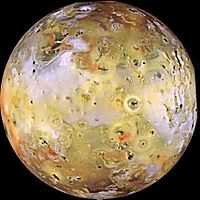
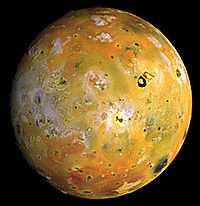
_from_Galileo_and_Voyager_missions.jpg)
_from_Galileo_and_Voyager_missions.jpg)
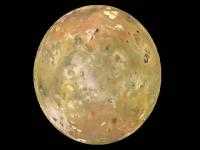
In the image at right, "[t]he smallest features that can be discerned are 2.5 kilometers in size. There are rugged mountains several kilometers high, layered materials forming plateaus, and many irregular depressions called volcanic calderas. Several of the dark, flow-like features correspond to hot spots, and may be active lava flows. There are no landforms resembling impact craters, as the volcanism covers the surface with new deposits much more rapidly than the flux of comets and asteroids can create large impact craters. The picture is centered on the side of Io that always faces away from Jupiter; north is to the top."[1]
"Color images acquired on September 7, 1996 have been merged with higher resolution images acquired on November 6, 1996 by the Solid State Imaging (CCD) system aboard NASA's Galileo spacecraft. The color is composed of data taken, at a range of 487,000 kilometers, in the near-infrared, green, and violet filters and has been enhanced to emphasize the extraordinary variations in color and brightness that characterize Io's face. The high resolution images were obtained at ranges which varied from 245,719 kilometers to 403,100 kilometers."[1]
The second image at right continues around Io to the left.
The third image is of Io's north pole. "[The] new basemap [and the polar images] of Jupiter's moon Io was produced by combining the best images from both the Voyager 1 and Galileo Missions. Although the subjovian hemisphere of Io was poorly seen by Galileo, superbly detailed Voyager 1 images cover longitudes from 240 W to 40 W and the nearby southern latitudes. A monochrome mosaic of the highest resolution images from both Galileo and Voyager 1 was assembled that includes 51 Voyager 1 images with spatial resolutions sometimes exceeding the 1 km/pixel scale of the final mosaic. Because this mosaic is made up of images taken at various local times of day, care must be taken to note the solar illumination direction when deciding whether topographic features display positive or negative relief. In general, the illumination is from the west over longitudes 40 to 270 W, and from the east over longitudes 270 W to 40 W. Color information was later superimposed from Galileo low phase angle violet, green, and near-infrared (756 nanometer wavelength) images. The Galileo SSI camera's silicon CCD was sensitive to longer wavelengths than the vidicon cameras of Voyager, so that distinctions between red and yellow hues can be more easily discerned. The "true" colors that would be visible to the eye are similar but much more muted than shown here. Image resolutions range from 1 to 10 km/pixel along the equator, with the poorest coverage centered on longitude 50 W."[10]
The fourth image is of Io's south pole.
The last image is an animated image showing a 1 Io day of rotation. "In the same way that the Moon always has the same side facing Earth, Io always has the same side facing Jupiter. The movie shows two speeded-up rotations of Io (a single rotation really takes 1.77 days), and begins with a view of the Jupiter-facing hemisphere. With rotation in an easterly direction, after two seconds the volcano Prometheus (on the equator) comes into view. The massive red deposit around Pele (seconds 5-10) is the most distinctive expression of volcanic activity on Io, and just to the north-west is the horse shoe-shaped Loki Patera, the most powerful volcano on Io. The animation was made using a computer program that wrapped the Io mosaic around a sphere to produce a globe. In all, 360 images were used, each differing by one degree in longitude from the previous image."[11]
Reds
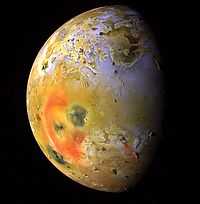
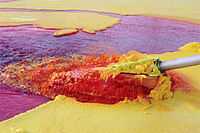
The image at right is a "global view of Jupiter's moon, Io, ... obtained during the tenth orbit of Jupiter by NASA's Galileo spacecraft. Io, which is slightly larger than Earth's moon, is the most volcanically active body in the solar system. In this enhanced color composite, deposits of sulfur dioxide frost appear in white and grey hues while yellowish and brownish hues are probably due to other sulfurous materials. Bright red materials, such as the prominent ring surrounding Pele, and "black" spots with low brightness mark areas of recent volcanic activity and are usually associated with high temperatures and surface changes. One of the most dramatic changes is the appearance of a new dark spot (upper right edge of Pele), 400 kilometers (250 miles) in diameter which surrounds a volcanic center named Pillan Patera. The dark spot did not exist in images obtained 5 months earlier, but Galileo imaged a 120 kilometer (75 mile) high plume erupting from this location during its ninth orbit. North is to the top of the picture which was taken on September 19, 1997 at a range of more than 500,000 kilometers (310,000 miles) by the Solid State Imaging (SSI) system on NASA's Galileo spacecraft."[12]
At volcanic locations, native liquid sulfur can be seen flowing, such as in the image second down on the right, and it is red.
Craters


On the left is a mosaic of Voyager 1 images covering Io's south polar region. The view includes two of Io's ten highest peaks, the Euboea Montes at upper extreme left and Haemus Mons at bottom.
The pair of images on the right changes in surface features for the eight years between Galileo and New Horizons observations.
Volcanoes
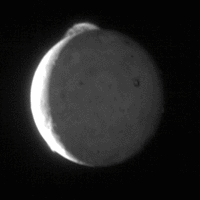
On the left is a five-image sequence of New Horizons images showing Io's volcano Tvashtar spewing material 330 km above its surface.
Io "is the innermost of the four Galilean moons of the planet Jupiter and, with a diameter of 3,642 kilometres (2,263 mi), the fourth-largest moon in the Solar System. ... With over 400 active volcanoes, Io is the most geologically active object in the Solar System.[13][14] ... Most of Io's surface is characterized by extensive plains coated with sulfur and sulfur dioxide frost. ... Io's volcanism is responsible for many of the satellite's unique features. Its volcanic plumes and lava flows produce large surface changes and paint the surface in various shades of yellow, red, white, black, and green, largely due to allotropes and compounds of sulfur."[15]
Active regions
“Io has no impact craters; it is the only object in the Solar System where we have not seen any impact craters, testifying to Io’s very active volcanic resurfacing.”[16]
"Io is extremely active, with literally hundreds of volcanic sources on its surface. Interestingly, although Io is so volcanically active, more than 25 times more volcanically active than Earth, most of the long-term surface changes resulting from volcanism are restricted to less than 15 percent of the surface, mostly in the form of changes in lava flow fields or within paterae."[17]
“Our mapping has determined that most of the active hot spots occur in paterae [broad, flat dishes or saucers], which cover less than 3 percent of Io’s surface. Lava flow fields cover approximately 28 percent of the surface, but contain only 31 percent of hot spots.”[16]
“Understanding the geographical distribution of these features and hot spots, as identified through this map, are enabling better models of Io’s interior processes to be developed.”[16]
Research
Hypothesis:
- The volcanoes of Io originate from the current flowing through Io.
Control groups

The findings demonstrate a statistically systematic change from the status quo or the control group.
“In the design of experiments, treatments [or special properties or characteristics] are applied to [or observed in] experimental units in the treatment group(s).[18] In comparative experiments, members of the complementary group, the control group, receive either no treatment or a standard treatment.[19]"[20]
Proof of concept
Def. a “short and/or incomplete realization of a certain method or idea to demonstrate its feasibility"[21] is called a proof of concept.
Def. evidence that demonstrates that a concept is possible is called proof of concept.
The proof-of-concept structure consists of
- background,
- procedures,
- findings, and
- interpretation.[22]
See also
References
- 1 2 3 "File:Iosurface gal.jpg, In: Wikimedia Commons". San Francisco, California: Wikimedia Foundation, Inc. September 15, 2011. Retrieved 2012-07-17.
- ↑ John Spencer (November 2000). "John Spencer's Astronomical Visualizations". Boulder, Colorado USA: University of Colorado. Retrieved 2013-04-05.
- 1 2 3 4 Peter Goldreich and Donald Lynden-Bell (April 1969). "Io, a jovian unipolar inductor". The Astrophysical Journal 156 (04): 59-78. doi:10.1086/149947.
- ↑ Kinwah Wu, Mark Cropper, Gavin Ramsay, and Kazuhiro Sekiguchi (March 2002). "An electrically powered binary star?". Monthly Notices of the Royal Astronomical Society 321 (1): 221-7. doi:10.1046/j.1365-8711.2002.05190.x.
- 1 2 3 Thomas Gold (November 1979). "Electrical Origin of the Outbursts on Io". Science 206 (4422): 1071-3. doi:10.1126/science.206.4422.1071.
- 1 2 3 4 5 6 7 8 Ronald F. Elsner, G. Randall Gladstone, J. Hunter Waite, Frank J. Crary, Robert R. Howell, Robert E. Johnson, Peter G. Ford, Albert E. Metzger, Kevin C. Hurley, Eric D. Feigelson, Gordon P. Garmire, Anil Bhardwaj, Denis C. Grodent, Tariq Majeed, Allyn F. Tennant, Martin C. Weisskop (June 2002). "Discovery of Soft X-Ray Emission from Io, Europa and the Io Plasma Torus". The Astrophysical Journal 572 (2): 1077-82. doi:10.1086/340434. http://arxiv.org/pdf/astro-ph/0202277v1.pdf. Retrieved 2016-03-12.
- ↑ John T. Clarke, Gilda E. Ballester, John Trauger, Robin Evans, J. E. P. Connerney, Karl Stapelfeldt, David Crisp, Paul D. Feldman, Christopher J. Burrows, Stefano Casertano, John S. Gallagher III, Richard E. Griffiths, J. Jeff Hester, John G. Hoessel, Jon A. Holtzman, John E. Krist, Vikki Meadows, Jeremy R. Mould, Paul A. Scowen, Alan M. Watson, and James A. Westphal (October 1996). "Far-Ultraviolet Imaging of Jupiter's Aurora and the lo "Footprint"". Science 274 (5286): 404-9. doi:10.1126/science.274.5286.404. http://adsabs.harvard.edu/abs/1996Sci...274..404C. Retrieved 2016-03-12.
- 1 2 Sue Lavoie (May 31, 2001). "PIA03450: Io Color Eclipse Movie". Tucson, Arizona USA: NASA/JPL/University of Arizona. Retrieved 2013-05-30.
- 1 2 Sue Lavoie (October 13, 1998). "PIA01637: Io's Aurorae". Pasadena, California: NASA and the Jet Propulsion Laboratory, California Institute of Technology. Retrieved 2012-07-22.
- ↑ "File:Io (north pole) from Galileo and Voyager missions.jpg, In: Wikimedia Commons". San Francisco, California: Wikimedia Foundation, Inc. September 19, 2011. Retrieved 2012-07-18.
- ↑ "File:Iorotateing1day.ogg. In: Wikimedia Commons". San Francisco, California: Wikimedia Foundation, Inc. August 3, 2011. Retrieved 2012-07-18.
- ↑ "File:PIA01667-Io's Pele Hemisphere After Pillan Changes.jpg, In: Wikimedia Commons". San Francisco, California: Wikimedia Foundation, Inc. September 15, 2010. Retrieved 2012-07-17.
- ↑ Rosaly MC Lopes (2006). "Io: The Volcanic Moon". In Lucy-Ann McFadden, Paul R. Weissman, Torrence V. Johnson. Encyclopedia of the Solar System. Academic Press. pp. 419–431. ISBN 978-0-12-088589-3.
- ↑ R. M. C. Lopes et al. (2004). "Lava lakes on Io: Observations of Io’s volcanic activity from Galileo NIMS during the 2001 fly-bys". Icarus 169 (1): 140–74. doi:10.1016/j.icarus.2003.11.013.
- ↑ "Io (moon), In: Wikipedia". San Francisco, California: Wikimedia Foundation, Inc. June 7, 2012. Retrieved 2012-06-08.
- 1 2 3 David Williams (March 19, 2012). "Geologic map of Jupiter’s moon Io details an otherworldly volcanic surface". Tempe, Arizona USA: Arizona State University. Retrieved 2014-03-28.
- ↑ Nikki Cassis (March 19, 2012). "Geologic map of Jupiter’s moon Io details an otherworldly volcanic surface". Tempe, Arizona USA: Arizona State University. Retrieved 2014-03-28.
- ↑ Klaus Hinkelmann, Oscar Kempthorne (2008). Design and Analysis of Experiments, Volume I: Introduction to Experimental Design (2nd ed.). Wiley. ISBN 978-0-471-72756-9. http://books.google.com/?id=T3wWj2kVYZgC&printsec=frontcover.
- ↑ R. A. Bailey (2008). Design of comparative experiments. Cambridge University Press. ISBN 978-0-521-68357-9. http://www.cambridge.org/uk/catalogue/catalogue.asp?isbn=9780521683579.
- ↑ "Treatment and control groups, In: Wikipedia". San Francisco, California: Wikimedia Foundation, Inc. May 18, 2012. Retrieved 2012-05-31.
- ↑ "proof of concept, In: Wiktionary". San Francisco, California: Wikimedia Foundation, Inc. November 10, 2012. Retrieved 2013-01-13.
- ↑ Ginger Lehrman and Ian B Hogue, Sarah Palmer, Cheryl Jennings, Celsa A Spina, Ann Wiegand, Alan L Landay, Robert W Coombs, Douglas D Richman, John W Mellors, John M Coffin, Ronald J Bosch, David M Margolis (August 13, 2005). "Depletion of latent HIV-1 infection in vivo: a proof-of-concept study". Lancet 366 (9485): 549-55. doi:10.1016/S0140-6736(05)67098-5. http://www.ncbi.nlm.nih.gov/pmc/articles/PMC1894952/. Retrieved 2012-05-09.
External links
- African Journals Online
- Bing Advanced search
- Google Books
- Google scholar Advanced Scholar Search
- International Astronomical Union
- JSTOR
- Lycos search
- NASA/IPAC Extragalactic Database - NED
- NASA's National Space Science Data Center
- NCBI Site Search
- Office of Scientific & Technical Information
- PubChem Public Chemical Database
- Questia - The Online Library of Books and Journals
- SAGE journals online
- The SAO/NASA Astrophysics Data System
- Scirus for scientific information only advanced search
- SDSS Quick Look tool: SkyServer
- SIMBAD Astronomical Database
- SIMBAD Web interface, Harvard alternate
- Spacecraft Query at NASA.
- SpringerLink
- Taylor & Francis Online
- Universal coordinate converter
- Wiley Online Library Advanced Search
- Yahoo Advanced Web Search
![]() This is a research project at http://en.wikiversity.org
This is a research project at http://en.wikiversity.org
| |
Development status: this resource is experimental in nature. |
| |
Educational level: this is a research resource. |
| |
Resource type: this resource is an article. |
| |
Resource type: this resource contains a lecture or lecture notes. |
| |
Subject classification: this is an astronomy resource. |